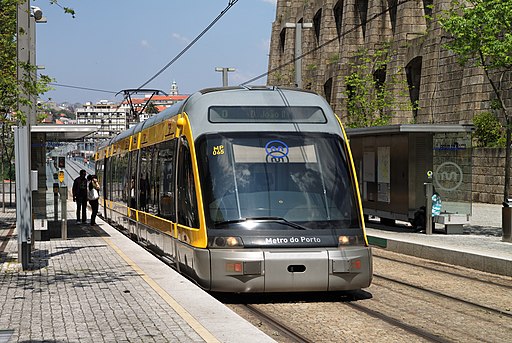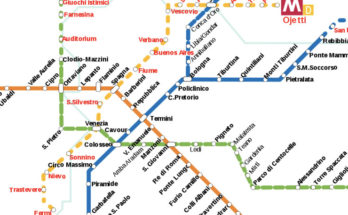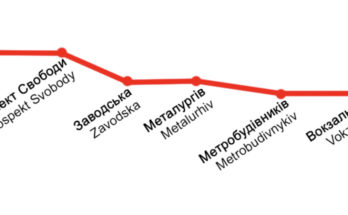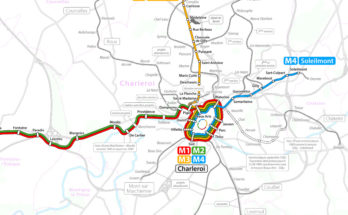Porto Metro is a mass transit system which operates throughout the metropolitan area that includes the city proper and 7 other municipalities: Porto, Gondomar, Vila Nova de Gaia, Póvoa de Varzim, Matosinhos, Vila do Conde and Maia. The system operates 6 lines over a track length of 67km and serves 81 working stations.
Unlike other european metros which are underground, most of the system is above ground with only 8kms underground in the city center. This makes Porto Metro officially a light rail system. The Porto Metro became operational in 2002. The last estimates of 2011, showed the metro on average transported 152,000 passengers. The light rail is now operated by ViaPORTO.
- Lines and Stations
- Line A: Estádio do Dragão – Senhor de Matosinhos (Blue Line)
- Line B: Estádio do Dragão – Póvoa de Varzim (Red Line)
- Line C: Campanhã – ISMAI (Green Line)
- Line D: Hospital São João – Santo Ovídio (Yellow Line)
- Line E: Estádio do Dragão – Aeroporto (Violet Line)
- Line F: Fânzeres – Senhora da Hora (Orange Line)
- Funicular dos Guindais : Batalha – Ribeira
- Porto Metro Hours
- Porto Metro Fares, Tickets, and Cards
- Rules and Tips
- Porto Metro Trains
Lines and Stations
The Porto Metro has 6 lines and 81 operational stations. All 6 lines identify by their letter and color.
Line A: Estádio do Dragão – Senhor de Matosinhos (Blue Line)
The A line passes through downtown Porto via Trinidade and runs between Senhor de Matosinhos and Estádio do Dragão.
It’s 23 stations and 15,6 Kms long.
This line is also known as Matosinhos Line. Journey time is 40 min. and frequency about 10 mins.
Stations: Estádio do Dragão, Campanhã, Heroísmo, Campo 24 de Agosto, Bolhão, Trindade, Lapa, Carolina Michaelis, Casa da Música, Francos, Ramalde, Viso, Sete Bicas, Senhora da Hora, Vasco da Gama, Estádio do Mar
Line B: Estádio do Dragão – Póvoa de Varzim (Red Line)
The B line runs from the port Póvoa de Varzim to Estádio do Dragão. Also passing through a seaside resort Via Do Condo.
It’s 35 stations and length of the line is 33,6 kms.
It is also known as Povoa Line. Journey time is 61 min and frequency is 30 mins.
Stations: Estádio do Dragão, Campanhã, Heroísmo, Campo 24 de Agosto, Bolhão, Trindade, Lapa, Carolina Michaelis, Casa da Música, Francos, Ramalde, Viso, Sete Bicas, Senhora da Hora, Fonte do Cuco, Custóias, Esposade, Crestins, Verdes, Pedras Rubras, Lidador, Vilar de Pinheiro, Modivas Sul, Modivas Centro, Modivas Norte, Mindelo, Espaço Natureza, Varziela, Árvore, Azurara, Santa Clara, Vila do Conde, Alto de Pega, Portas Fronhas, São Brás, Póvoa de Varzim
Line C: Campanhã – ISMAI (Green Line)
C line runs between ISMAI and Estádio do Dragão. With a travel time lasting 41, minutes from end to end. It has 24 stations and its track length is 19,6 kms.
It’s also known as Maia/Trofa Line. Frequency: 15 min.
Stations: Campanhã, Heroísmo, Campo 24 de Agosto, Bolhão, Trindade, Lapa, Carolina Michaelis, Casa da Música, Francos, Ramalde, Viso, Sete Bicas, Senhora da Hora, Fonte do Cuco, Cândido dos Reis, Pias, Araújo, Custió, Parque Maia, Fórum Maia, Zona Industrial, Mandim, Castêlo da Maia, Ismai
Line D: Hospital São João – Santo Ovídio (Yellow Line)
The D line cross the river and runs from north to south. The line operates between Santo Ovídio and Hospital São João.
It’s 16 stations and is 9,2 kms long.
Also known as Gaia line. Journey time: 25 min. Frequency: 6 min.
Stations: Hospital São João, IPO, Pólo Universitário, Salgueiros, Combatentes, Marquês, Faria Guimarães, Trindade, Aliados, São Bento, Jardim do Morro, General Torres, Câmara Gaia, João de Deus, D. João II, Santo Ovídio, Quinta do Cedro, Laborim, Hospital Santos Silva, Vila d’Este
Line E: Estádio do Dragão – Aeroporto (Violet Line)
E line runs between Airport and Estádio do Dragão with a travel time of 35 minutes and a 30-minute headway.
It’s 21 stations and 16,7 kms. long. Also known as Aeropuerto (Airport) line.
Stations: Estádio do Dragão, Campanhã, Heroísmo, Campo 24 de Agosto, Bolhão, Trindade, Lapa, Carolina Michaelis, Casa da Música, Francos, Ramalde, Viso, Sete Bicas, Senhora da Hora, Fonte do Cuco, Custóias, Esposade, Crestins, Verdes, Botica, Aeroporto
Line F: Fânzeres – Senhora da Hora (Orange Line)
Line F operates between Senhora da Hora and Fânzeres, with a travel time of 39 minutes. It serves 24 stations through 17,4 kms of tracks.
Also known as Gondomar line. Frequency: 15 minutes
Stations: Fânzeres, Venda Nova, Carreira, Baguim, Campainha, Rio Tinto, Levada, Nau Vitória, Nasoni, Contumil, Estádio do Dragão, Campanhã, Heroísmo, Campo 24 de Agosto, Bolhão, Trindade, Lapa, Carolina Michaelis, Casa da Música, Francos, Ramalde, Viso, Sete Bicas, Senhora da Hora
Funicular dos Guindais : Batalha – Ribeira
Just 2 stations and 300 meters length.
Also Known as Funicular/Elevator dos Guindais. Journey time: 3 mins. Frequency: 4 mins.
Stations: Batalha, Ribeira
* All lines run through the Trinidade station, making it the central hub.
Porto Metro Hours
The working hours are from 6:00am to 1:00am the next morning. On the weekend (Friday & Saturday) the light rail is part of the Move Porto scheme, and runs 24-hours only for the Yellow Line (D), Santo Ovídio and Hospital S. João, and Blue Line (A) Estádio do Dragão and Senhora da Hora. The Move Porto scheme teams up the metro with local M buses which all run 24-hours. The system helps integrate all public transit in the metropolitan area.
Porto Metro Fares, Tickets, and Cards
The ticketing system based on the Andante Cards. It’s a smart card system that allows the user to top off the cards. In other words, you can reload them for multiple uses. The Andante Blue Card is the most common as it used more like an occasional ticket. There’s also the Andante Gold Card that’s more personalized and use more like a credit card. The andante cards are part of the public transit system and are valid with the Metro, STCP buses, and the CP suburban trains.
The Andante blue card allows two forms of cards to buy. There’s the 1 day (24-hour period) and the 3 day (72-hour period) card by which the clock begins from the first ride. The average cost for the blue card is 7 euros for the 1-day pass, and 15 euros for the 3-day pass. As the most common card, it’s easily purchased at all Metro and STCP stations or counters, Andante Stores, Airport, and Tourist Office.
Andante gold card is different from the blue card as its more personalized. The gold card has a scanned photo of the owner of the card because the card carries the commuters picture it cannot be discarded. Since cards are repeatedly used, there are reload options points at Multibanco ATM terminals. Another difference from the blue card, is that the gold card can only be purchased from Andante Stores.
Single ticket for one zone is 1,10€. With Porto and Andante Tour cards there’s no rides limits. Check updated fares in Porto’s Subway Website.
Rules and Tips
Proof of payment is done by yellow machines at the station. The cards are passed in front of the yellow machines, once validated you can board. This is your responsibility before boarding as there’s no fare gates at the platforms. However, while on the light rail fare inspectors have the right to ask for your ticket and carry card scanners. If one isn’t present, a fine 77 euros applies.
The Porto metro differs from the Lisbon metro, the other metro system in Portugal. The Lisbon metro has museums and other perks included in the purchase of the cards. This isn’t the case for the Porto Metro, don’t be confused as the cards work for public transit only.
To open the doors on the light rail a green button must be pressed on the train, and the button is for exiting and entering the metro. Remember to be on the right side of the station to avoid going in the wrong direction
The trains and platforms are equipped to deal with the handicapped and vision impaired. If someone is colorblind there’s a system in place to explain the color patterns of lines.
The metro is less crowed after hours and on the weekends. Keep this in mind if you don’t like crowds.
Bicycles are welcomed aboard the trains and have designated areas. The designated areas are designed not to disturb walking commuters which works in the favor of both the bicyclist and walking commuters. The spacious design of light rails makes all this possible.
Porto Metro Trains
The trains are electrical making them environmentally friendly. They’re on par with other metros in Europe using Euro-tram technology conserving 30 percent of power when braking. The trains can reach a maximum speed of 100km/h. One of the advantages of light rail compared to traditional metros is that it has more seats and common space. Each carriage seats 80 and 134 standing passenger capacity.
This post is also available in: French German Spanish Portuguese (Brazil)



